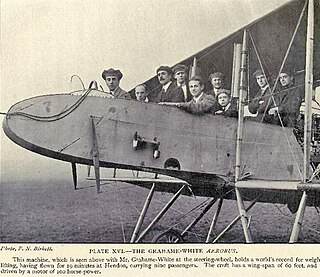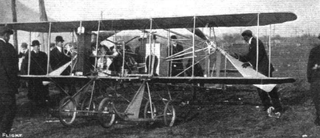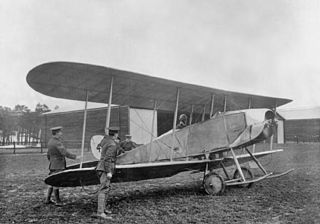Related Research Articles

The Boxkite was the first aircraft produced by the British and Colonial Aeroplane Company. A pusher biplane based on the successful Farman III, it was one of the first aircraft types to be built in quantity. As the type was used by Bristol for instruction purposes at their flying schools at Larkhill and Brooklands many early British aviators learned to fly in a Boxkite. Four were purchased in 1911 by the War Office and examples were sold to Russia and Australia. It continued to be used for training purposes until after the outbreak of the First World War.
The Bristol Biplane Type 'T', sometimes called the Challenger-Dickson Biplane, was a derivative of the Bristol Boxkite. It was built in 1911 by the British and Colonial Aeroplane Company and was designed as a cross-country racing aircraft for Maurice Tabuteau.

The Royal Aircraft Factory F.E.1 was designed and built in 1910 by the pioneer designer Geoffrey de Havilland. He used it to teach himself to fly during late 1910. After De Havilland was appointed assistant designer and test pilot at the Army Balloon Factory at Farnborough in December 1910 the War Office bought the aircraft for £400. the aircraft was given the designation F.E.1

The Avro Type E, Type 500, and Type 502 made up a family of early British military aircraft, regarded by Alliott Verdon Roe as his firm's first truly successful design. It was a forerunner of the Avro 504, one of the outstanding aircraft of the First World War.

The Bristol Gordon England biplanes were a series of early British military biplane aircraft designed by Eric Gordon England for the Bristol Aeroplane Company that first flew in 1912. Designed for easy ground transport, the aircraft could be quickly disassembled.

The Farman III, also known as the Henry Farman 1909 biplane, was an early French aircraft designed and built by Henry Farman in 1909. Its design was widely imitated, so much so that aircraft of similar layout were generally referred to as being of the "Farman" type.

The Grahame-White Type X Charabanc or Aerobus was a 1910s British passenger-carrying biplane designed and built by the Grahame-White Aviation Company based at Hendon Aerodrome, North London.
The Grahame-White Ganymede was a prototype British heavy night bomber intended to serve with the Royal Air Force in the First World War. A large, three-engined, twin-boom biplane, the sole prototype Ganymede did not fly until after the war had ended, and although an attempt was made to convert the aircraft to an airliner, it was unsuccessful.

The Wright Model R was a single-seat biplane built by the Wright Company in Dayton, Ohio, United States, in 1910. Also known as the Roadster or the Baby Wright, it was designed for speed and altitude competitions.

The Dunne D.8 of 1912 was a tailless swept wing biplane, designed by J. W. Dunne to have inherent stability. One example was supplied to RAE Farnborough. License-built Burgess-Dunne models were used by the US Signal Corps and United States Navy and the short-lived Canadian Aviation Corps. It was the latter's first and only warplane.

The Royal Aircraft Factory B.E.3 was a single-engined rotary engined biplane developed by the British Royal Aircraft Factory prior to the First World War. The B.E.4 and B.E.7 were virtually identical aircraft that differed only in the engine fitted.

The ASL Viking was a single-engined two seater biplane aircraft designed and built by Horatio Barber's Aeronautical Syndicate Ltd. at Hendon. It was first flown in January 1912.
The Bristol Glider was an early British two-seat biplane glider designed in 1910s by George Challenger and built by the British & Colonial Aeroplane Company at Filton Aerodrome, Bristol.

The Howard Wright 1910 Biplane was an early British aircraft built by Howard T. Wright to a design by W.O. Manning. One was used by Thomas Sopwith for his early record-breaking flights. Another made the first powered flight in New Zealand.
The Bristol Racing Biplane was a British single-seat biplane designed to combine the performance of a monoplane but using the strength of the biplane. It was designed by Robert Grandseigne and Léon Versepuy, who were supervised by George Challenger for the British & Colonial Aeroplane Company of Bristol, it crashed on its first flight.
The Graham-White Type VII "Popular" was an early British aircraft designed by J. D. North and built by the Grahame-White Aviation company, with the intention of producing a low-cost aircraft to popularize aviation. It was initially produced with a 35 hp Anzani 3-cylinder Y configuration engine and offered for sale at a price of less than £400. Despite its low price the aircraft included structural refinements such as hollow-section interplane struts. It was first flown in 1913.
The Short S.80 was an early British floatplane built by Short Brothers for Frank McClean to undertake an aerial expedition up the Nile to investigate the cataracts between Aswan and Khartoum. After a successful flight to Khartoum it was returned to England, where it was used for training by the RNAS. When built it was the largest successful aircraft that had been constructed in Britain. It was also known as the Short Nile Pusher Biplane Seaplane.

The Radley-England Waterplane was a British floatplane designed and built by James Radley and Gordon England to take place in the 1913 Circuit of Britain race. Damaged before the start of the race, it was unable to compete and was subsequently rebuilt as the Radley-England Waterplane 2

The Sommer 1910 Biplane was an early French aircraft designed by Roger Sommer. It was a pusher configuration biplane resembling the successful Farman III, and was built in large numbers for the time. One was owned by Charles Rolls.
The Bristol P.B.8, or Bristol-Coanda P.B.8', was an early British-built, Romanian-designed two-seat biplane trainer made by the Bristol Aeroplane Company in 1914. Only one was completed, which was never flown.
References
- Notes
- Bibliography
- Lewis, P. British Aircraft 1809-1914 London, Putnam 1962
- Taylor M.J. H. Jane's Encyclopedia of Aviation.London: Studio Editions, 1989
- Flugsport 1911
- aerofiles
- Flightglobal Archive